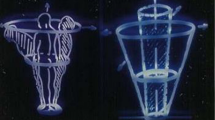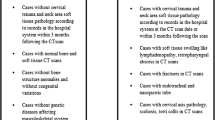Abstract
Purpose
Because of the complex cervical vertebral embryology and some normal variations, the atlantoadental interval (ADI) was not suitable for the evaluation of the anatomic relationship between the atlas and axial in children less than 2 years old. And the influence of the age and gender on the anatomic relationship between atlas and axial in children was still unclear. Two novel parameters, atlas-axis anteroposterior distance (AAAD) and atlas-axis lateral distance (AALD), were invented to evaluate the anatomic relationship between the atlas and axis in the children no more than 8 years old with different age and gender.
Methods
Cross-sectional computed tomography (CT) scans of the atlantoaxial joint for 140 randomly selected pediatric patients no more than 8 years old were analyzed. On the ideal CT reconstruction images, AAAD, AALD, atlantoaxial lateral bending angle (AALB), and atlantoaxial rotation angle (AARA) were measured.
Results
There was no statistically significant difference between the mean AAAD in different age and gender groups. The 99% confidence interval for AAAD was 7.12–7.82 mm. There was no significant correlation between AAAD and AALB/AARA and AALD and AALB/AARA.
Conclusion
The AAAD was less than 7.12 mm or much than 7.82 mm that suggested a possible instability in the atlantoaxial joint and could help the diagnosis of the atlantoaxial instability in children no more than 8 years old. There was no difference between the mean AAAD of pediatric patients no more than 8 years old in different age and gender groups.



Similar content being viewed by others
Abbreviations
- AAA:
-
anterior atlas arch
- AAAD:
-
atlas-axis anteroposterior distance
- AAI:
-
atlantoaxial instability
- AALB:
-
atlantoaxial lateral bending angle
- AALD:
-
atlas-axis lateral distance
- AARA:
-
atlantoaxial rotation angle
- ADI:
-
atlantodental interval
- CT:
-
computed tomography
- PAA:
-
posterior atlas arch
References
Yang HS, Kim KW, Oh YM, Eun JP (2017) Usefulness of titanium mesh cage for posterior C1-C2 fixation in patients with atlantoaxial instability. Medicine (Baltimore) 96:e8022. https://doi.org/10.1097/MD.0000000000008022
Lustrin ES, Karakas SP, Ortiz AO, Cinnamon J, Castillo M, Vaheesan K, Brown JH, Diamond AS, Black K, Singh S (2003) Pediatric cervical spine: normal anatomy, variants, and trauma. Radiographics 23:539–560. https://doi.org/10.1148/rg.233025121
Bahadur R, Goyal T, Dhatt SS, Tripathy SK (2010) Transarticular screw fixation for atlantoaxial instability-modified Magerl’s technique in 38 patients. J Orthop Surg Res 5:87. https://doi.org/10.1186/1749-799X-5-87
Singh B, Cree A (2015) Laminar screw fixation of the axis in the pediatric population: a series of eight patients. Spine J 15:e17–e25. https://doi.org/10.1016/j.spinee.2014.10.009
Johnson KT, Al-Holou WN, Anderson RC, Wilson TJ, Karnati T, Ibrahim M, Garton HJ, Maher CO (2016) Morphometric analysis of the developing pediatric cervical spine. J Neurosurg Pediatr 18:377–389. https://doi.org/10.3171/2016.3.PEDS1612
Karwacki GM, Schneider JF (2012) Normal ossification patterns of atlas and axis: a CT study. AJNR Am J Neuroradiol 33:1882–1887. https://doi.org/10.3174/ajnr.A3105
Piatt JH Jr, Grissom LE (2011) Developmental anatomy of the atlas and axis in childhood by computed tomography. J Neurosurg Pediatr 8:235–243. https://doi.org/10.3171/2011.6.PEDS11187
Menezes AH (2008) Craniocervical developmental anatomy and its implications. Childs Nerv Syst 24:1109–1122. https://doi.org/10.1007/s00381-008-0600-1
Junewick JJ, Chin MS, Meesa IR, Ghori S, Boynton SJ, Luttenton CR (2011) Ossification patterns of the atlas vertebra. AJR Am J Roentgenol 197:1229–1234. https://doi.org/10.2214/AJR.10.5403
Zhang XB, Luo C, Li M, Zhang X, Hui H, Zeng Q, Li TY, Zhang DW, Zhang YY, Wang C, Liu CK, Liu X, Qu XY, Cao YJ, Zhou H, Weng LQ (2018) Clinical significance of imaging findings for atlantoaxial rotatory subluxation in children. Turk J Med Sci 48:332–338. https://doi.org/10.3906/sag-1707-137
Rojas CA, Hayes A, Bertozzi JC, Guidi C, Martinez CR (2009) Evaluation of the C1-C2 articulation on MDCT in healthy children and young adults. AJR Am J Roentgenol 193:1388–1392. https://doi.org/10.2214/AJR.09.2688
Liu K, Xie F, Wang D, Guo L, Qi Y, Tian J, Zhao B, Chhabra A (2015) Reference ranges for atlantodental interval in adults and its variation with age and gender in a large series of subjects on multidetector computed tomography. Acta Radiol 56:465–470. https://doi.org/10.1177/0284185114530284
Osmotherly PG, Farrell SF, Digby SD, Rowe LJ, Buxton AJ (2013) The influence of age, sex, and posture on the measurement of atlantodental interval in a normal population. J Manip Physiol Ther 36:226–231. https://doi.org/10.1016/j.jmpt.2013.04.004
Hinck VC, Hopkins CE (1960) Measurement of the atlanto-dental interval in the adult. Am J Roentgenol Radium Therapy, Nucl Med 84:945–951
Vanek P, Bradac O, de Lacy P, Pavelka K, Votavova M, Benes V (2017) Treatment of atlanto-axial subluxation secondary to rheumatoid arthritis by short segment stabilization with polyaxial screws. Acta Neurochir 159:1791–1801. https://doi.org/10.1007/s00701-017-3274-1
Meyer C, Bredow J, Heising E, Eysel P, Müller LP, Stein G (2017) Rheumatoid arthritis affecting the upper cervical spine: biomechanical assessment of the stabilizing ligaments. Biomed Res Int 2017:6131703. https://doi.org/10.1155/2017/6131703
Akobo S, Rizk E, Loukas M, Chapman JR, Oskouian RJ, Tubbs RS (2015) The odontoid process: a comprehensive review of its anatomy, embryology, and variations. Childs Nerv Syst 31:2025–2034. https://doi.org/10.1007/s00381-015-2866-4
O’Brien WT, Shen P, Lee P (2015) The dens: normal development, developmental variants and anomalies, and traumatic injuries. J Clin Imaging Sci 5:38. https://doi.org/10.4103/2156-7514.159565
Baumgart M, Wiśniewski M, Grzonkowska M, Małkowski B, Badura M, Dąbrowska M, Szpinda M (2016) Digital image analysis of ossification centers in the axial dens and body in the human fetus. Surg Radiol Anat 38:1195–1203. https://doi.org/10.1007/s00276-016-1679-9
Henderson P, Desai IP, Pettit K, Benke S, Brouha SS, Romine LE, Beeker K, Chuang NA, Yaszay B, van Houten L, Pretorius DH (2016) Evaluation of fetal first and second cervical vertebrae: normal or abnormal. J Ultrasound Med 35:527–536. https://doi.org/10.7863/ultra.14.12044
Deng XW, Min ZH, Lin B, Zhang FH (2010) Anatomic and radiological study on posterior pedicle screw fixation in the atlantoaxial vertebrae of children. Chin J Traumatol 13:229–233
Cattrysse E, Provyn S, Kool P, Clarys JP, Van Roy P (2011) Morphology and kinematics of the atlanto-axial joints and their interaction during manual cervical rotation mobilization. Man Ther 16:481–486. https://doi.org/10.1016/j.math.2011.03.002
Salem W, Lenders C, Mathieu J, Hermanus N, Klein P (2013) In vivo three-dimensional kinematics of the cervical spine during maximal axial rotation. Man Ther 18:339–344. https://doi.org/10.1016/j.math.2012.12.002
Cattrysse E, Provyn S, Kool P, Gagey O, Clarys JP, Van Roy P (2009) Reproducibility of kinematic motion coupling parameters during manual upper cervical axial rotation mobilization: a 3-dimensional in vitro study of the atlanto-axial joint. J Electromyogr Kinesiol 19:93–104. https://doi.org/10.1016/j.jelekin.2007.06.019
Cattrysse E, Baeyens JP, Kool P, Clarys JP, Van Roy P (2008) Does manual mobilization influence motion coupling patterns in the atlanto-axial joint. J Electromyogr Kinesiol 18:838–848. https://doi.org/10.1016/j.jelekin.2007.02.015
Panjabi MM, Oda T, Crisco JJ 3rd, Dvorak J, Grob D (1993) Posture affects motion coupling patterns of the upper cervical spine. J Orthop Res 11:525–536. https://doi.org/10.1002/jor.1100110407
Funding
This study was funded by the Science and Technology Program of Wenzhou China (Grant No. Y20180031), the Zhejiang Provincial Natural Science Foundation of China (Grant No. LY14H060008) and the National Natural Science Foundation of China (Grant No. 81572214).
Author information
Authors and Affiliations
Corresponding author
Ethics declarations
Conflict of interest
The authors declare that they have no competing interests.
Ethical approval
All procedures performed in studies involving human participants were in accordance with the ethical standards of the institutional and/or national research committee and with the 1964 Helsinki declaration and its later amendments or comparable ethical standards.
Informed consent
Informed consent was obtained from all individual participants included in the study.
Additional information
Publisher’s note
Springer Nature remains neutral with regard to jurisdictional claims in published maps and institutional affiliations.
Rights and permissions
About this article
Cite this article
Wu, L., Jin, Y., Wang, XY. et al. Two novel parameters to evaluate the influence of the age and gender on the anatomic relationship of the atlas and axis in children no more than 8 years old: imaging study. Neuroradiology 61, 1407–1414 (2019). https://doi.org/10.1007/s00234-019-02284-z
Received:
Accepted:
Published:
Issue Date:
DOI: https://doi.org/10.1007/s00234-019-02284-z




